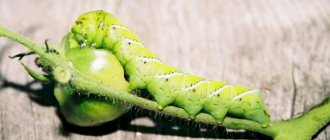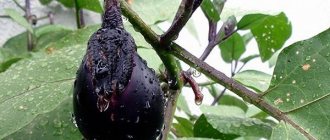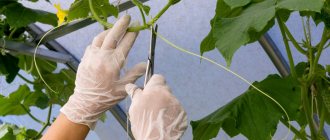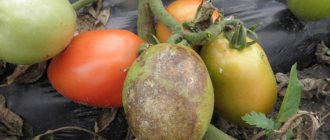Basic methods of struggle
To combat tomato cutworm use:
- manual collection of caterpillars;
- spraying with chemicals;
- treatment with folk remedies;
- biological method.
Chemicals
How to deal with green caterpillars on tomatoes in a greenhouse? Chemical treatment is the most effective method of pest control. Spraying is carried out taking into account the fact that pesticides are removed from the fruit within 20-30 days. Therefore, before using chemicals, calculate the expected start date of harvest.
List of effective means:
- "Inta-Vir" is a contact-intestinal insecticide. The substance cypermethrin destroys butterflies and caterpillars. The protective effect lasts up to 15 days. Dissolve 1 tablet in 10 liters of water and use it during the tomato growing season.
- "Decis Profi" is a fast-acting contact-intestinal insecticide. Belongs to the class of pesticides moderately hazardous to humans. Contains the substance deltamethrin. To treat 100 m², 0.5 g of the substance is dissolved in 5 liters of water. The product is used before flowering. The protection period is 10-15 days.
- "Avant" is an insecticide of moderate hazard class for humans. Contains the substance indoxacarb. Resistant to rain, effectively destroys eggs and caterpillars. The consumption rate per 1 ha is 200-300 ml. The product is used no more than twice during the growing season.
- "Arrivo" is a contact-intestinal insecticide. Shows high effectiveness against cutworm caterpillars at low application rates. Consumption per 1 ha – 240-320 ml. Treatment is one-time, during the growing season.
- "Aktara" is a systemic insecticide with contact-intestinal action. The active ingredient is thiamethoxam. Destroys the caterpillar at the feeding stage. 4 g of powder for irrigation or 1.2 g for spraying are dissolved in 10 liters of water.
- "Tanrek" is a systemic insecticide with contact-intestinal action. The active ingredient is imidacloprid. The protection period is 30 days. The drug can be combined with Fitosporin. The product is used for spraying (5 ml per 10 liters of water).
- "Fitoverm" is an enteric contact insectoacaricide. Irrigation is carried out twice during the entire growing season. 1 ml of the drug is dissolved in 10 liters of water. The protection period in the greenhouse is up to 20 days, in the garden – up to 15 days.
Folk remedies
Folk remedies are effective in detecting the first pests. Unfortunately, in case of mass destruction, they do not bring results.
Recipes for folk remedies:
- Pour a bunch of chopped garlic arrows or a head of garlic into 1 liter of hot water and leave for 3-4 days. Bring the product to a volume of 10 liters and use it to treat bushes twice a month.
- Pour 300 g of tobacco dust into 10 liters of boiling water and leave for 24 hours. Apply to spray tomatoes every two weeks.
- Fill a galvanized barrel with chopped bird cherry herbs and fill it to the top with boiling water. Leave for a day, use for spraying bushes and watering the soil.
- Pour a kilogram of fresh wormwood into 3 liters of water and boil for half an hour, then increase the volume to 10 liters and irrigate the bushes twice with an interval of two weeks.
- Fill a 10-liter bucket with burdock, chamomile, datura, yarrow, celandine, potato tops (optional) and fill with water. Leave for four days and use to irrigate bushes once every two weeks.
Mix shavings of laundry or tar soap into each solution. For a 10 liter bucket – 30-50 g.
A saline solution is effective against cutworms. Dissolve 2 tbsp in 10 liters of water. l. rock salt and water the bushes generously.
Biological methods of control
What to do if caterpillars eat tomatoes in a greenhouse? To fight them, their natural enemies are used. Microscopic Trichogramma insects lay eggs inside cutworm eggs. Damaged cocoons turn black after 2-3 days. The method is used twice a season.
The caterpillar parasite bracon provides significant assistance in the fight against armyworms. The female insect pierces the caterpillar's skin and injects a toxin that destroys the digestive system.
Fighting caterpillars: general rules
Caterpillars on tomatoes in a greenhouse: how to deal with them? To combat it, it is necessary to apply an integrated approach, which contains the following measures:
- In the spring, constantly destroy weeds. This will help reduce the number of larvae and butterflies.
- Inspect greenhouses regularly, especially during the flowering period.
- Spray with chemicals “Iskra” and “Leptotsid”. Repeat spraying after a week, since the caterpillars do not all appear at once. Then only biological substances can be used, because the period of ripening and harvesting does not tolerate chemicals. Repeat treatment 2-3 times.
- Do not allow the caterpillar to form to large sizes.
- In the autumn, it is necessary to destroy all remnants of plants that have been damaged by the caterpillar and dig up the bed.
- During the summer season, it is recommended to loosen the soil from time to time.
Step-by-step instructions for fighting
With a cutworm butterfly in the garden
The armyworm and the fight against it have a number of features. Read below on how to deal with cutworms in your garden.
Prediction using pheromone traps. Traps show the exact time of the beginning of butterfly flight and the appearance of caterpillars. Initially, the summer passed during the flowering period of dandelions. But now all deadlines are shifted and extended in time
Therefore, forecasting is very important for timely action.
To avoid poisoning plants with chemicals, you should first try to remove the cutworm using folk remedies. Attracting the cutworm's natural enemies - Trichogramma and Bracona. Hang bait traps throughout the garden. If the effectiveness is insufficient, biological products against cutworms are used. If they do not help to completely get rid of the butterflies, use the “heavy artillery”. Control measures for the fall armyworm should include chemical insecticides. At the end of the gardening season, it is worth digging up all the soil deeply, since cutworms overwinter in the soil
After digging, most of the pests die.
Now you know how to get rid of cutworms in your garden. About scoop caterpillars, how to fight further.
With caterpillars
- At the beginning of the season, dig the soil as deep as possible to reduce the number of overwintering pests.
- When planting, use alternation of different plant crops.
- Be sure to eliminate weeds that serve as the initial food supply for the larvae.
- When the first single specimens appear, they begin to be collected manually.
- If the number of caterpillars begins to increase, a means is selected to destroy them.
It is recommended to use gentle drugs from the group of folk or biological ones.
If they are ineffective, biological products are replaced with chemical insecticides. After harvesting, deep digging of the site is used again.
The cutting armyworm methods for dealing with it are below.
With a gnawing scoop
- The main measure to reduce the number is digging up the soil to a depth of at least 25 cm. This is carried out twice a season - before planting and after harvesting. This procedure will get rid of most existing pests in the caterpillar and pupa stages;
- After planting the plants, they regularly loosen the soil between the rows and beds with a thorough inspection. All discovered caterpillars are immediately removed and destroyed;
- eliminate weeds not only in the garden, but also around the entire site;
- lure the gnawing moth butterfly into traps from a fermenting drink - kvass, molasses, beer, compote;
- To destroy the larvae that live in the ground, it is necessary to use soil insecticides.
Some experienced gardeners use a tank mixture of the drug (1/2 of the required dose) with urea (100 g per bucket of water).
Control measures for cotton bollworm are slightly different, more on that below.
With cotton boll
The cotton bollworm is a quarantine pest against which special measures are taken. How to deal with it further.
Quarantine procedures include:
unrelenting control over purchased seedlings, seedlings and bushes
Particular attention should be paid to cotton, chrysanthemums, tomatoes, corn, roses and eggplants. But remember that the cotton bollworm is an almost omnivorous pest; if a pest is detected, the entire batch of purchased sprouts is fumigated, as well as the container; widespread and active use of pheromone traps.
Photos of the scoop and the fight against it, see below.
How to deal with the scoop? The subsequent struggle is:
- In compliance with all rules of agricultural technology in closed greenhouses and in open areas.
- Constant monitoring and identification of pests at all stages of development.
- Thorough and timely removal of weeds and their subsequent burning.
- Preventive treatment of suspicious plants with chemical insecticides.
Advice from vegetable growers
Caterpillars on tomatoes in a greenhouse: how to deal with them using the advice of experienced summer residents? Baits for caterpillars and cutworms are made from sweet drinks, syrups, kvass, beer, and juices that can ferment. Place the bait in small jars. It is necessary to remove caterpillars that have fallen for the bait.
To repel butterflies, eggshells are used, which are placed between plants. Birds, especially tits and sparrows, love to feast on larvae and caterpillars, they will help reduce the number of pests. You can hang feeders for birds.
Plant cilantro and basil next to the tomatoes; cutworms cannot tolerate the aroma of these herbs, so they will fly around your plantings.
Signs of defeat
Since the armyworm itself is difficult to see during the daytime, its development can be identified by several signs:
- there are white areas on the leaves of tomatoes that are colonized with eggs;
- green or brown caterpillars have taken root on leaves and stems and are visible especially in the evening;
- the leaves have small holes that enlarge over time and leave behind only large veins;
- the buds are damaged, and with them the ovary on the fruit;
- Tomato fruits have holes with eaten away pulp;
- the foliage turns black, dries quickly and falls off, the fruits become dark brown and begin to rot.
Signs of caterpillars appearing in a greenhouse
I recognize its appearance by characteristic signs:
- Small and adult pests appear on the lower part of the leaves.
- The upper part of the leaf is covered with white “powder” and then turns black.
- Tops affected by caterpillars dry out and curl.
- Affected tomatoes have inedible, whitish pulp.
- The tops have characteristic features: “bite” marks, uneven edges, empty spots.
- There are gnawed passages on the tomatoes, and the pests themselves are in the pulp.
Cutworm caterpillars are clearly visible to the naked eye. Adult whiteflies can be easily detected by shaking the plants - the butterflies will swirl in the air.
Protecting tomatoes from caterpillars
Flying insects and their voracious caterpillars cause significant damage to tomato beds in greenhouses. A humid and warm microclimate in enclosed spaces creates the preconditions for the rapid reproduction and development of pests. Gardeners combat them by treating plants with chemicals. Gardeners who do not accept the use of pesticides on their territories are seeking to completely destroy and repel winged and crawling insects using folk remedies and methods.
Methods and recipes from the people
| Recipes | Ingredients | Preparation | Usage |
| Garlic infusion | Whole head of garlic or 200 g arrows Water 1 liter | Grind all ingredients and pour boiling water, leave for 3 days, before use add ½ cup of infusion and 50 g of laundry soap in 10 liters of water | Processing of tomatoes in a greenhouse is carried out several times at intervals of 7-10 days. |
| Wormwood decoction | Water 10 liters Fresh wormwood 500 g | The wormwood is poured with water, brought to a boil and boiled for 30 minutes, kept under the lid for 2 days, filtered. Before use, dilute the decoction with water 1:10 and add 1/3 of a bar of soap | Spray tomato bushes 2-3 times a month |
| Tobacco infusion | Tobacco dust 300 g Water 7-10 liters | Pour fine tobacco into boiling water, stir, leave for 1 day, filter, add soap | Tomato bushes are sprayed with a hand sprayer, trying to get on the back side of the leaves. Treatment must be carried out until the pests are completely gone. |
| Salt solution | Water 10 liters Salt 100 g | The salt is dissolved in water, after 30 minutes the solution is filtered | Use a saline solution no more than once a month when there is a large accumulation of caterpillars and larvae on tomato bushes |
| Potato tops infusion | Fresh potato stems 1 kg Water 10 l | The tops are poured with boiling water and left for 24 hours, filtered, and 50 g of liquid or grated soap are added. | Tomato bushes are watered from above, then they pass with a broom and lightly shake off the solution from the bushes so that it gets on the inside of the leaves; the treatment must be carried out until the pests are completely destroyed |
Whiteflies and cutworms are sensitive to odors; planting green manure plants among tomato bushes: garlic, celery, coriander helps to repel them. The butterflies will leave the greenhouse, will look for a more suitable place to lay eggs, and the caterpillars will gradually die from the effects of infusions and solutions.
Attention! During the flowering period of cultivated plants, treatments should be carried out carefully; there is a risk of scaring off beneficial insects that pollinate tomatoes. In greenhouses there are much fewer of them than pests. Take care of such workers.
Take care of such workers.
Prevention
Before the onset of winter, the caterpillars go into the soil, pupate and mummify until spring. Whiteflies and cutworms overwinter at a depth of 10 to 25 cm, to protect tomatoes from their invasion next season, you need to:
- In the fall, dig up the beds freed from tomato bushes to a depth of at least 30 cm (the bayonet of a shovel), turning over and without breaking the clods of earth. Pupated caterpillars that are on top will die from the cold in winter.
- In early spring, water the soil for tomatoes with hot water with the addition of soda or potassium permanganate. Pupae of pests, if they are preserved, will die under the influence of heat treatment.
- Before planting tomato seedlings in a greenhouse, you can sow white mustard seeds in the beds (2 months before). Immediately before planting tomatoes, dig up the beds along with mustard seedlings, and then spray the seedlings with a weak solution of dry powder.
Preserving the harvest and not letting it be eaten by insatiable caterpillars is the primary task of gardeners. Preventive measures using folk remedies are effective in such cases and do not harm either humans or the environment.
https://youtube.com/watch?v=xuVordp5QFE
External manifestations of pest activity
Tomato cutworm caterpillars, reaching a length of more than 20 cm, in most cases infect plantings. The pest has a large and elongated green body, on top of which there are 3 stripes. They have a light green tint. The parasite's peak activity occurs at the beginning of summer, when butterflies emerge from pupae. Their size in adult form ranges from 2.5 to 4.5 cm. The flying insect, which is characterized by a nocturnal lifestyle, has on the surface of its wings a pronounced pattern of stripes and figures, reminiscent in its shape of the Latin letter “Z”.
Important! Cutworms are actively breeding. During 1 season, 1 individual hatches 500 eggs or more on the surface of buds, leaves and flowers
The masonry can be identified by its external features. The egg has a pronounced convex top and a flat base. The rate of egg development depends on external conditions. With a stable temperature background and humidity level, the young animals will appear within 3-6 days, and under unfavorable conditions - within 4-10 days.
The young growth, whose development period is 18-20 days, first attacks the leaves of tomatoes, and then the buds and flowers. If the gardener leaves the situation without proper attention, then within a few weeks the caterpillars will destroy the fruits. Regular preventive inspection of seedlings is the only effective way to notice the pest at an early stage.
Who harms tomatoes on the surface of the earth
The most common above-ground pests of tomatoes are armyworms and whiteflies.
The armyworm damages tomatoes at night. This caterpillar emerges from eggs laid by moths. First, the cutworm damages the apical leaves, and when it matures a little, it destroys buds, ovaries and flowers. But the sabotage does not end there. When the fruits appear, they are also attacked. The moth caterpillars make passages in them.
Two generations of armyworms appear during the season: from May to mid-July, from July to mid-September. Therefore, tomato pest control should be carried out throughout the season. You can determine whether the cutworm is harming your tomato harvest by leaving a jar of sour compote next to the plants overnight. If in the morning there are butterflies in it, then it’s time to take action. Planting calendula, spraying the leaves with an infusion of garlic arrows or its cloves, and an infusion of burdock leaves will help fight the cutworm.
Whitefly on tomatoes usually appears in greenhouses in the middle zone, and in the South in unprotected soil. When whiteflies appear, tomato leaves become covered with a black coating similar to soot. This is due to the fact that pests use plant sap for nutrition, and its excess forms a sticky film on which fungi settle. The plant withers and dies. To detect cutworms, just touch the plant and a white swarm of insects rises from it. The damage is caused by the larvae. It is at this stage that you can fight the armyworm. Plants covered with sticky substance stop breathing, so they need to be washed regularly with soapy water. Often this is enough. Special adhesive tapes are also very effective. Among biological methods, dandelion infusion works well. For this, leaves and rhizomes are used, filled with water and infused for 3 hours. You can also use a water infusion of garlic.
Don't lose your crop to pests. Don't miss the moment and don't let them multiply.
Useful tips and advice
It is not advisable to plant tomatoes too close to each other. Because of this, it is convenient for pests to move to neighboring plants, and their population grows rapidly.
Tomatoes need daily watering. The soil must be moistened moderately so as not to create a favorable environment for caterpillars to reproduce. Tomatoes are watered early in the morning, when the sun has not yet had time to warm the ground. Water should only be poured at the root of the plant. It is also advisable to water the soil in winter. Because of this, insect pupae that are in the ground die.
How to exterminate the garden cutworm?
Just like cabbage, potato and exclamation point, the garden cutworm is more than dangerous to the crop. The insect prefers tomatoes, cabbage and radishes, but is not averse to eating other types of crops. Caterpillars of this subspecies are usually green or brown in color.
The main danger of the pest lies in its habit of laying eggs on almost all crops indiscriminately. Typically, the insect chooses the inner surface of the leaf, where young larvae appear and consume fruits and leaves of plants.
Chemicals and traditional methods also have their effect if done correctly. So, for example, in the spring you can use Proteus, Fury, Decis - these are drugs for pest control. In summer, the effect can be achieved by treating crops with solutions of phosphorus, fufanol and zolon.
It is worth choosing drugs that are most convenient to use - in granules or powder. Concentrated emulsions require careful dilution and pose a major health hazard in case of skin contact.
Biological methods
In nature, the enemies of pest caterpillars are Trichogramma. They lay eggs in the cocoons of butterflies, thereby destroying garden pests. Insects can be purchased at a special store. They are released onto tomato bushes 3 times per season. It is necessary to plant 5000 trichograms per 1 hectare of land.
Bracones pose a danger to caterpillars. These are predatory flies that parasitize the larvae of other insects. The females pierce the caterpillar's cover and inject poison, which stops the digestive system. Then the adult injects about 20 larvae into the victim’s body. Bracons eat the caterpillar from the inside until they reach adulthood.
What can you use to fight?
When deciding to get rid of caterpillars on tomatoes, you need to prepare for a systematic fight from the very beginning. It is possible to save plantings only in a comprehensive manner; most often it is necessary to do more than one approach of spraying chemicals, since pests breed several generations of offspring. Simply treating fruit-bearing tomatoes won’t work either; in this case, you need to select methods and methods of control especially carefully. It is better to spray them with biological agents that are safe for the further development of plants.
Saving plants from whiteflies can be hampered by the butterfly's rapid adaptation to the effects of chemicals. Even during the season, the pest can be destroyed only by regularly changing the means used to poison the insects. There are no universal formulations that allow you to simply spray tomato bushes to make the pests disappear.
Chemicals
The most effective means of combating caterpillars on tomatoes are industrially produced insecticides. They are used as a preventative measure, as well as directly to destroy emerging insects. The main disadvantage of such compositions is their ability to accumulate in plant organs. The average period for cleaning crops from pesticides is 20-30 days. Accordingly, they can be used no later than a month before the start of fruiting.
Among the chemicals that have proven most effective in the fight against caterpillars, several drugs can be distinguished.
"Decis". The drug has extremely low toxicity and gives quick results. Suitable for preventive treatment of tomatoes during the growing season.
Working with pesticides, especially in greenhouses, requires careful adherence to safety measures. You need to follow the dosage and use protective equipment. Only by following all the manufacturer's recommendations can you get a good result.
Biological agents
In the fight against cutworm caterpillars and whiteflies on tomatoes, you can also use less aggressive methods of destroying them. Biological drugs include Leptocid. This product is aimed at destroying the larvae of different types of butterflies and has a repellent effect against adult insects. Spraying is carried out superficially, during the vegetative development of plants, the composition has a short withdrawal period without a persistent cumulative effect.
The drug “Bitoxibacillin” has a similar effect. It is better to use it repeatedly, with a week break. And also their natural enemy, Trichogramma, does a good job of breeding caterpillars. This predator can be purchased in specialized stores, and then simply placed in a greenhouse or on a plot. The population will have to be updated three times during the season.
Traditional methods
Through experience, gardeners often find not the most trivial means and methods of control that can become a good alternative to pesticides. Among the well-proven options, there are several popular ones.
- Infusion of mustard powder. To do this, 100 g of dried and crushed plant is steamed in 10 liters of water and left for 2 days. The resulting solution is sprayed onto the shoots and leaves of the plant.
- Saline solution. In high concentrations it is deadly to caterpillars. The mixture is prepared from 5 liters of warm water and 400 g of salt. The prepared mixture is sprayed onto tomato bushes. For better adhesion, you can add liquid soap to the solution.
- Wormwood infusion. It is prepared from freshly cut shoots of the plant, filling 1/3 of a bucket with them. Then the wormwood is filled with water and simmered over low heat for 30 minutes. After this, the broth is sent to infuse for 2 days, and then filtered, diluted with water in a ratio of 1:10.
How dangerous is the cutworm?
Armyworm caterpillars are one of the most serious crop pests. If you do not notice their appearance in the garden in time, you can lose most of the tomatoes and other vegetable crops.
The danger of insects is as follows:
- a large number of pest eggs;
- difficulty in determining the moment when caterpillars emerge from oviposition;
- rapid change of generations of insects throughout the summer;
- caterpillars are difficult to detect - they eat tomato bushes only at night and hide in the soil during the day;
- a plant with eaten leaves quickly dries out and dies;
- damaged tomatoes rot quickly;
- omnivorous pest - the cutworm eats tomatoes, eggplants, beans, corn and other plants grown in the garden.
What plants are pests afraid of?
It is believed that less labor-intensive means can be used as a preventive measure against caterpillar attacks. For example, plant nearby plants that repel butterflies with their scent when they are ready to lay eggs. The following types of green defenders help well against cutworms and whiteflies:
- calendula;
- coriander;
- celery.
These plants are rich in essential oils and emit a strong and pungent aroma. They scare away butterflies flying in search of food. This type of protection works best in open ground conditions. In this case, you can place the “marigolds” around the perimeter of the garden bed, and place the coriander and celery among the tomato bushes.
Sowing white mustard in early spring has an interesting effect. This is a green manure plant that improves the composition of the soil. Its first shoots are dug up along with the soil, while simultaneously destroying possible insect nests. In such a plot, tomatoes will grow more abundantly.
External manifestations of caterpillar activity
You can notice that pests have appeared on tomatoes based on several signs:
- The tomato leaves are covered with a white coating.
- Holes appear in green fruits.
- The foliage turns black, quickly dries out and falls off.
- The tomatoes turn dark brown and fall off the branches.
- At night, white and gray butterflies fly over the tomatoes.
You can check for caterpillars in your area using a butterfly trap. To make it, a regular plastic bottle with a narrow neck is suitable. Sweet fermented liquid is poured inside. Kvass, jam or berry compote will do. The trap is set at night. If in the morning there are several pest butterflies inside the jar, parasitic caterpillars have settled on the tomatoes.
How to fight
There are several methods of pest control:
- agrotechnical (plowing the soil, killing weeds);
- mechanical (catching butterflies with bait, manually collecting caterpillars);
- chemical (spraying plantings with insecticides);
- biological (spraying with biological pesticides and folk remedies).
It is most effective to use all measures in combination.
Agrotechnical method
In the fall, cutworm caterpillars go into the soil, turn into pupae, and spend the winter in this form. In spring, the pupa turns into a butterfly. Autumn plowing to a depth of 15–20 cm will help destroy the pupae. The cutworm pupae that end up on the surface will die in the cold. For the same purpose, spring cultivation of the site is carried out immediately after the snow melts.
Mowing weeds on the site and beyond will help reduce the armyworm population. The cutworm butterfly feeds on flower pollen. By depriving her of food, the gardener forces her to look for food elsewhere
Particular attention should be paid to the destruction of nettles, quinoa and goosefoot - her favorite plants
Mechanical method
In small areas, cutworms can be controlled without resorting to chemicals. As soon as moths begin to fly, traps are prepared for them - wide, deep plates or troughs with water filled with beer or jam. Butterflies flock to the bait and drown in the water.
Chemical method
When the pest population is high and over large areas, insecticides are indispensable. The following drugs are used:
- Decis (1 ml of the drug per 10 liters of water at 250 m);
- Samurai;
- Karate (1 ml per bucket of water, per 100 m2 area);
- Proteus (7 ml diluted in 5 liters of water, the solution is enough to process 1 hundred square meters);
- Fury or Kinmiks from the group of pyrethroids (1.5 ml of the drug is dissolved in 10 liters of water);
- Bazudin in granules is incorporated into the soil in an amount of 200 g per hundred square meters.
Biological method
A method of combating the cutworm that does not harm nature: they use the butterfly’s natural enemies by introducing Trichogramma into the area, which eats the laid eggs. The predator is released during the egg-laying period of the butterfly, in the amount of 300 - 400 individuals per hundred square meters.
Biological preparations will help cope with the pest: Fitoverm, Bitoxibacillin (50 g per 10 liters of water). Treatment should be carried out in the evening in dry weather, at air temperatures above 20 degrees.
Folk remedies
Opponents of chemicals on the site successfully use infusions of various herbs to repel and destroy the cutworm.
- Sagebrush. Stems and leaves (1 kg per 3 liters of water) are boiled for 15 - 20 minutes. The cooled broth is sprayed onto the seedlings.
- 100 g of hot pepper is boiled in a liter of water for about 30 - 40 minutes. The resulting liquid is diluted 8 times with clean water.
- Onion. The crushed half of the onion is infused overnight in a liter of water. The strained infusion is sprayed on plants during the flight of cutworm butterflies.
- Garlic. Several cloves are poured with hot water (1 liter) and left for 3 days. The liquid for use is diluted with water 5 times.
- Burdock. The chopped leaves and stems are placed tightly in a bucket and filled to the top with water. After 3 days, the infusion can be sprayed. For better adhesion to foliage, add 50 g of liquid soap to it.
- To prevent the appearance of the pest, it is necessary to maintain the area free of weeds. Till the soil in autumn and spring, watch for the appearance of butterflies and take action immediately.
A butterfly that lays worms on tomatoes - tomato cutworm: description, photo
There are many varieties of cutworms. Basically, they all differ in brown, gray or black color. The main activity occurs at night and evening hours. At this time, they eat leaves and damage all garden crops. It is worth noting that cutworms attack not only tomatoes, but also cabbage, cucumbers, beans and carrots. Cutworm caterpillars, which mainly live in the ground and eat the roots of plants, cause great harm. They also sometimes eat ground leaves that are very close to the ground.
Armyworm caterpillar
It is worth noting that the cutworm overwinters below ground and butterflies appear in the first half of May. They fly until the third ten days of July. The butterfly is very active. At night after an active summer, females lay eggs on weeds. It is worth noting that the female is very fertile. Therefore, if you do not control pests, you can lose your entire vegetable crop.
Owl butterfly
The garden armyworm is most common in Ukraine and the southern regions of Russia. There are two ways out, that is, two summers of butterflies. The first one falls in the month of May. The second year falls in August. Accordingly, almost all crops are susceptible to damage. Small, that is, the youngest caterpillars eat only the lower part of the leaves, giving them a skeletal appearance. Older caterpillars eat all the leaves completely, without even leaving veins, and also damage the fruits and form large, irregularly shaped hollows in them.
Owl butterfly
Folk remedies
If you are against chemicals, or it is no longer possible to use extreme measures due to the ripeness of the crop, then in this case the following methods are quite applicable:
- Celandine, wormwood, tobacco and garlic are infused in a bucket of hot water for 24 hours in equal proportions per bucket of water. Next, this solution is filtered and mixed with planed soap to fix it on the sheet.
- Potato tops are infused in the same way, only it needs to stand for four hours. Insist on the ratio of a kilogram of tops to a bucket of water.
- You can sprinkle the plants with salt. Or dissolve it in water and thoroughly spray it on the foliage. For better adhesion, also secure with soap.
- A decoction of wormwood will also help against the scoop. It needs to be boiled for 15 minutes and applied twice every other week. You should take a kilogram of herbs and boil them in three liters.
- Caterpillars are also afraid of burdock. For those who have time, you can use the following recipe: pour fresh leaves with water and leave for three days. Process according to foliage.
Anti-aphid products are also excellent in the fight against cutworms.
Fight fire with fire
There are other ways to exterminate caterpillars. For example, setting those who feed on them against pests. The introduction of Trichogramma or Bracona is a well-known practice and is the main means of mass pest control. They are bred in laboratory conditions.
Trichogramma is an entomophagous insect. It is capable of destroying more than 160 species of caterpillars even in the egg phase. This predator is very effective at exterminating precisely those insects that are not so easy to detect, such as cutworms.
Thus, with the help of some insects you can successfully exterminate other insects that harm the crop. And do this at different stages of armyworm development.
Pests on tomatoes often cause significant damage
When fighting them, it is important to take into account that any means are most effective at the initial stage of plant infection. Therefore, planting monitoring should be carried out daily. Butterflies such as cutworms and whiteflies may not be immediately noticed, and their activity can lead to complete loss of the crop.
Butterflies such as cutworms and whiteflies may not be immediately noticed, and their activity can lead to complete loss of the crop.
Owl butterflies are quite inconspicuous in appearance, looking like a large moth. With open wings, their size is from 2.5 to 4.5 cm. The color is gray-brown, the wings are decorated with stripes, zigzags and strokes.
Cutworms are very prolific; one individual lays 500 or more eggs per season. Leaves 1-3 eggs on leaves, buds and flowers. The lower part of the eggs is flat, the top is convex, can be ribbed or honeycombed. Egg development occurs very quickly. In warm weather, the egg matures from 2 to 5 days, in cool weather - from 4 to 10.
The development period of caterpillars is about 20 days, sometimes faster. The body is naked, the color is gray, brown, yellow-green, not bright. The caterpillars go into the ground to a depth of about 10 cm and pupate there. The pupae overwinter in the soil.
During the season, butterflies fly out from 2 to 5 times, each lifespan is 20 – 40 days. The greatest danger to tomatoes is caterpillars. First they feed on leaves and buds, then they move on to fruits, gnaw holes and settle inside. Tomatoes damaged by caterpillars are unsuitable for eating.
Both butterflies and caterpillars are nocturnal.
Why are whiteflies dangerous?
Whiteflies are very small butterflies, more like midges. Their size is 1.5 - 3 mm. The body is white or yellowish, the wings are pollinated with white. If you move the plant on which they have settled, the whiteflies fly up in a white swarm.
They live on the underside of the leaf, sucking the juice from it. The upper surface of the leaves becomes covered with white dust, which turns black over time. The leaves curl and dry out.
The plaque spreads to the fruits and they spoil. The inside of damaged tomatoes is white.
The larvae of these butterflies are translucent. At first they are mobile, then they attach to the leaf and do not move.
Whiteflies become active in warm and humid weather, and die at temperatures below 10°C. The eggs of these butterflies are not afraid of the cold; they overwinter at sub-zero degrees in the upper layer of soil.
In addition to the harm caused by their vital activity, the danger of whiteflies is that they are carriers of bacterial diseases. Tomatoes stop growing, the fruits become deformed, and new ovaries do not form. After some time, the plant dies.
Both whiteflies and cutworms damage tomatoes both in open ground and in greenhouses. In addition, they move to other garden crops: eggplants, peppers, zucchini.
Description and types
The fight against the cutworm caterpillar begins with the information that the cutworm is not one insect, but about two thousand species living in Russia and united by the common name Latreille.
An adult butterfly has a wingspan of about 4.5 cm, but can be larger. The color is gray or gray-beige, similar in appearance to a moth. Lives from two weeks to a month. The caterpillar reaches 3 cm in length, it is green, sometimes brownish-pinkish. Develops within 40 days.
If cotton bollworm appears on tomatoes, control measures include treating the above-ground parts of the bush, and when a bollworm is found gnawing on tomatoes, control measures will require soil cultivation, since it can also gnaw on roots.
Prevention measures
Timely prevention will also help protect the area from pests. In order to prevent a large number of caterpillars from appearing in the beds or garden, you must adhere to important rules.
For planting on your site, you should choose only high-quality seedlings. Before planting, it must be thoroughly disinfected. You can also treat seedlings with growth stimulants. In this case, the seedlings will take root faster and will be stronger, as well as resistant to various diseases and pest attacks.
The soil must also be disinfected before planting seedlings. The easiest way is to pour boiling water over the dug up soil.
It is especially important to do this if there were previously a lot of pests in this area.
You should not allow weeds to appear on your site. They must be immediately dug up with roots and burned.
Beds and flower beds need to be weeded regularly so that the plants receive enough oxygen.
It will help to protect the area from caterpillars and planting plants with a pungent odor next to the beds or fruit trees. You can select onions, garlic, calendula, mint, and dill for the site.
In the fall, after cleaning the area, there should be no plant debris, leaves or debris left on it.
To learn how to effectively get rid of caterpillars, watch the following video.
Reasons for appearance
Plants should be inspected for pests especially carefully in several cases:
- Humid climate. Heavy rains and hot air are ideal weather for caterpillars to hatch from eggs. The soil in which the masonry is located becomes warm enough, which becomes a signal for insects.
- Abundance of fruit crops. If there are areas with vegetable gardens and orchards near a summer cottage, there is a high probability of caterpillars appearing. Butterflies quickly move through the air and capture new territories.
- Weed grass. During the flowering period, weeds attract pests to the site.
- Poor soil treatment. Butterflies lay eggs in the ground. To destroy the masonry, you need to dig up the top layer of soil. The minimum processing depth is 15 cm.
Fine-grained insect netting will help get rid of caterpillars in a greenhouse. It will not allow butterflies inside, which will protect the plants from pests.
A folk remedy for a hangover from the “piggy bank” of our ancestors or 8 best options
No. 1. Brine
For Russians, brine has become synonymous with the word “hangover.” It is with this remedy that many people treat themselves after a stormy feast. Why does brine help cure a hangover? It contains substances such as magnesium, potassium and sodium. It is these valuable elements that were lost by your body when excreting excess alcohol.
For brine to help with a hangover, you need to give preference to pickled vegetables: cabbage, tomatoes, cucumbers.
It is worth taking this folk remedy in an amount of no more than one glass, because it contains a lot of salt, which retains water. There is also a lot of acid in the brine, which is in excess in the body during a hangover. Therefore, excessive use of this drug can worsen your health.
No. 2. Tomato
Tomato juice and tomatoes themselves help saturate the body with vitamin C, potassium, sodium, acids and magnesium. This product improves stomach function.
Choose any folk remedy for a hangover using tomato:
| 1. | Add a pinch of ground red pepper to a glass of fresh tomato juice. This drink will help speed up your metabolism, which will allow you to remove toxins from your body faster. |
| 2. | Mix a glass of tomato juice in a blender with an egg and a pinch of salt. |
| 3. | A good hangover cure is a drink in which the ratio of tomato and kefir is 1:1. |
No. 3. Tea
To restore strength, it is better to use re-infusion rather than fresh. Add honey and lemon to your cup of tea to taste. If you experience vomiting and nausea during a hangover, then add ginger root to your tea. It helps improve stomach function.
No. 4. Eggs
An effective folk remedy for a hangover is a raw egg. The thing is that the white of a chicken egg prevents toxins from entering the blood. This property prevents a hangover from lasting for a long time.
Take note of this popular recipe:
- Shake 2 raw eggs
- add a pinch of salt,
- drink on an empty stomach.
You will notice the effect of this product literally after an hour.
No. 5. Dairy products
Any fermented milk product helps normalize stomach function, help restore the balance of minerals, speed up metabolism, quench thirst, and remove toxins.
Preference should be given to kefir, yogurt without additives, milk, curdled milk, fermented baked milk. It all depends on your personal preferences.
The use of this folk remedy has a number of indications:
- Sour milk should be at room temperature.
- It is better to take it immediately after waking up.
- You are allowed to drink no more than 700 ml per day.
- For the effect to be immediate, you do not need to mix fermented milk products with other foods.
No. 6. Bay leaf
Few people know that there is such a folk remedy for a hangover as a decoction of bay leaves.
It doesn’t matter at all whether you take dry or fresh leaves. This well-known nutritional supplement helps calm the nervous system, as well as cleanse the internal organs of poisons. Bay leaf has a sedative, diuretic, antiviral and antibacterial effect on the body.
Bay leaf has a sedative, diuretic, antiviral and antibacterial effect on the body.
To prepare a folk remedy for a hangover based on bay leaves, take 4 grams of the plant and 100 ml of water. This combination must be simmered for 10 minutes over low heat. Once the broth has cooled, divide it into equal portions and drink throughout the day. The maximum allowable volume is 2 glasses.
No. 7. Vitamin C
Lemon is a product accessible to absolutely every person. During a hangover, it helps get rid of nausea, speed up the processing of alcohol and the removal of toxins, eliminate headaches, normalize urination, and relieve fatigue.
There are two options for using it as a folk remedy for a hangover:
- The first is to eat lemon without sugar.
- If this option is not suitable for you, then simply add this product to mineral water. This drink perfectly quenches thirst and helps you forget about nausea.
Habitat
Carandrina inhabits a huge area, distributed throughout almost the entire territory of temperate and subtropical climates. Most often, the cutworm inhabits tomatoes:
- the European part of the Russian Federation;
- Southern Siberia;
- Urals;
- Far East;
- Baltic;
- Belarus;
- Ukraine;
- Moldova;
- Kazakhstan;
- Central Asia;
- China;
- Southern Europe;
- Africa;
- Australia;
- America.











